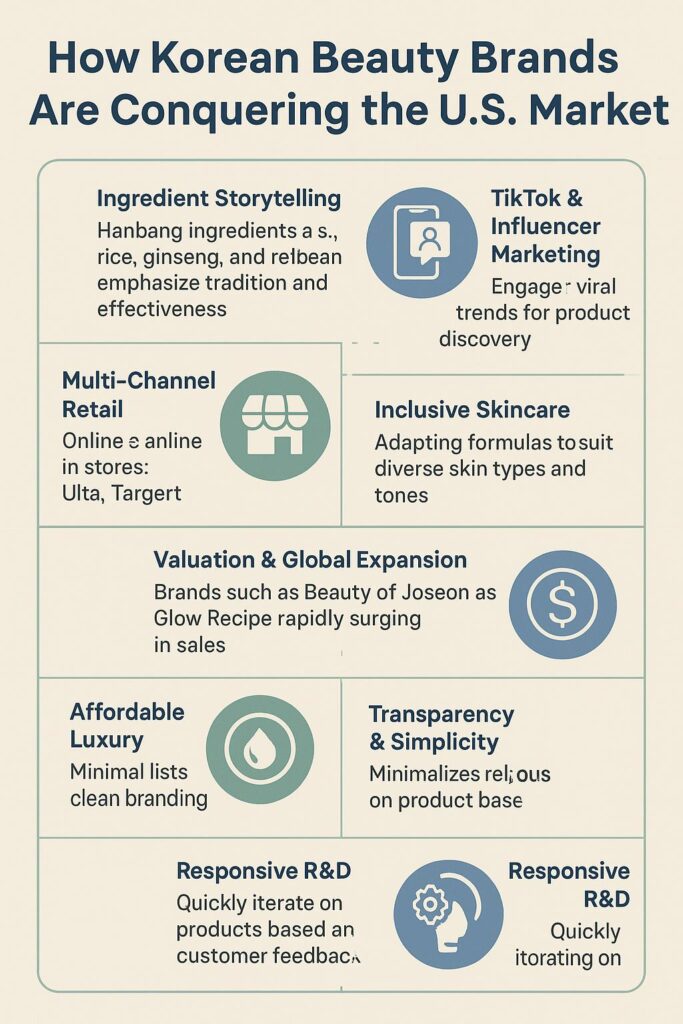
How Korean Beauty Brands Are Conquering the U.S. Market
Korean skincare brands are dominating the U.S. market by offering innovative formulas, clean ingredients, and powerful cultural storytelling. These brands, including Beauty of Joseon, Glow Recipe, and TIRTIR, have built a strong presence in the U.S. skincare industry through TikTok virality, affordable luxury, and inclusive product lines. The growing popularity of Korean skincare brands reflects not just global trends but also shifting consumer values in beauty.
Deep Roots Meet Modern Desires
One of the leading examples, Beauty of Joseon, draws on handbag ingredients which botanical compounds rooted in centuries-old Korean herbal medicine. By using elements like ginseng, rice water, and green plum extract, the brand creates a skincare experience that feels rich in cultural heritage yet light in formulation. For U.S. consumers, especially millennials and Gen Z shoppers, this fusion of history and modern skincare science feels refreshingly authentic.
Likewise, Glow Recipe fuses Korean innovation with Western-friendly packaging and fruity themes, making ingredients like watermelon and avocado both fun and effective. Meanwhile, TIRTIR has quickly gained momentum with its cushion foundations and mask-friendly makeup, building a loyal following through performance-first messaging and inclusive shade ranges.
These brands understand that modern consumers are increasingly ingredient-conscious, not just in what they eat, but also in what they apply to their skin. From minimalist product design to clean formulations, Korean brands like these manage to deliver trust and luxury without overpromising.
TikTok: The Launchpad for Modern Skincare
In the digital age, no beauty brand can thrive without a presence on TikTok. Beauty of Joseon saw this firsthand when its Relief Sun: Rice + Probiotics sunscreen began trending. It wasn’t because of paid campaigns but because of real users posting genuine results. The sunscreen’s light texture, affordable price, and no white cast made it a viral favorite.
1.Glow Recipe
Glow Recipe, on the other hand, leans heavily into TikTok aesthetics, often partnering with influencers who highlight its colorful packaging and juicy, skin-friendly textures. TIRTIR has also benefited from viral videos, particularly with makeup creators showcasing its long-lasting, transfer-proof coverage that performs under face masks.
2.Online Buzz to Retail Reality
Each of these brands capitalized on digital momentum by moving into the physical retail space. Beauty of Joseon products are now stocked at Ulta Beauty, Glow Recipe is a mainstay at Sephora, and TIRTIR is entering U.S. drugstores and lifestyle outlets. This multi-channel approach—online first, offline expansion later—builds both visibility and trust.
In-person shopping allows consumers to test textures, match shades, and build confidence in the product. Korean brands are proving that social proof and physical presence go hand in hand when it comes to lasting market impact.
3.Inclusivity and Innovation Across the Board
K-beauty was once criticized for not offering enough shade options or skin type flexibility. But that’s changing fast. TIRTIR expanded its cushion foundations to include dozens of shades. Glow Recipe reformulated products to target common concerns like hyperpigmentation and hormonal acne. Beauty of Joseon improved its textures to ensure no white cast appears on deeper skin tones.
This shift is more than a trend. It’s a necessity. U.S. consumers now expect inclusivity as a standard, not a bonus, and K-beauty brands are adapting quickly.
Valuation and Investor Momentum
While some brands like Beauty of Joseon remain privately held, Glow Recipe has crossed $100 million in annual U.S. sales, and TIRTIR’s sales doubled within a year thanks to viral interest and product diversification. Analysts predict the global K-beauty market will surpass $30 billion by 2032, with North America contributing a major portion.
These brands benefit from lean operations, efficient Korean manufacturing networks, and consumer loyalty. They’re crucial ingredients for long-term success.
Key Strategies That Set Them Apart
- Cultural Ingredient Storytelling: Brands explain the benefits of Hanbang (“한방”), fruit enzymes, or fermented extracts in relatable ways.
- TikTok and Influencer Engagement: Real user testimonials and before-after content drive engagement and conversions.
- Retail Integration: Online hype translates into shelf presence at major retailers.
- Product Innovation & Inclusivity: Fast reformulation cycles based on feedback ensure relevancy and accessibility.
- Global Readiness: Korean supply chains support rapid global scaling without sacrificing quality.
Final Thoughts
The success of brands like Beauty of Joseon, Glow Recipe, and TIRTIR shows that Korean skincare is no longer just a trend and it’s a serious competitor in the global market. These brands have cracked the code: speak authentically, deliver results, stay agile, and never lose sight of the consumer.
Their rise offers a clear lesson: heritage and innovation are not opposing forces. When used together, they become the ultimate formula for modern beauty.